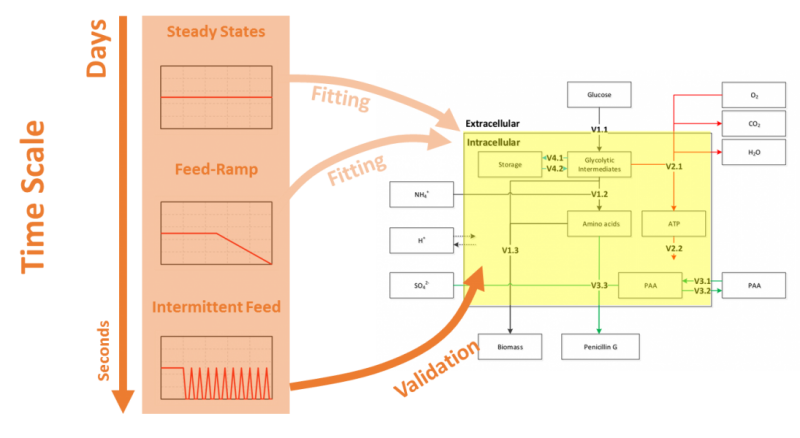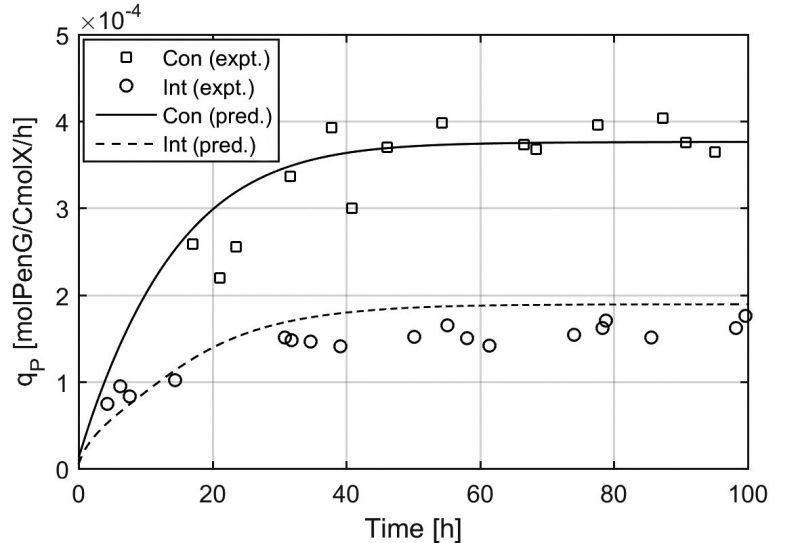
2017年3月14日,国际期刊《Biotechnology and Bioengineering》上在线发表了华东理工大学国家重点实验室、国家生化工程技术研究中心(上海)储炬教授课题组题为”A 9-pool metabolic structured kinetic model describing days to seconds dynamics of growth and product formation by Penicillium chrysogenum” 的研究论文。上海国佳生化工程技术研究中心有限公司项目负责人唐文俊为论文第一作者,储炬教授为论文通讯作者。相关研究为与荷兰DSM集团及荷兰代尔夫特理工大学共同开展。
青霉素的生物过程优化已经有了几十年的历史,其工业发酵规模已经达到数百吨,效价也已从最初的几十几百U/ml优化只十几万U/ml。然而,通过系统地生物学研究发现,当前的产能甚至不足菌株最大产能的50%,依旧具有较大的优化空间。更为重要的是,工业化的青霉素生产往往还会遇到实验室研究中不曾考虑的问题,其中最为主要的问题便是由于规模的增大导致吨级反应器内底物、溶氧、能量等不均一分布的出现,这也是生物过程工业放大所面临的最大问题。基于上述背景,国家生化工程技术研究中心(上海)与著名跨国生物企业荷兰DSM集团及国际一流院校荷兰代尔夫特理工大学共同开展基于理性工业放大的好氧发酵生物过程研究。以产黄青霉作为研究对象,通过建立与细胞生理学相关的细胞反应动力学模型(CRD)以及与生物反应器流场相关的计算流体力学计算框架(CFD),并将两者结合(CFD+CRD)来实现对于大型生物反应器的全尺寸模拟,并基于定量的模拟结果实现针对性的工业放大优化策略制定。该技术路线的难点便是建立相关的细胞动力学模型,该模型需要具备模型结构相对简单,模型鲁棒性强,动态过程模拟、秒至小时级细胞动力学特征的捕捉等。
唐文俊等通过对产黄青霉开展多批次不同稀释率下的恒化实验、小时级的连续稀释率变化实验、秒级的补料速率变化实验等获取了大量的精确定量胞内代谢物浓度信息,利用同种类/同工特性建立“池”的概念,利用基础元素守衡、电子及还原力守衡建立了一个具有5个代谢物池、4个相关调控酶池的结构化细胞代谢模型,并且为之建立了数十个相关动力学描述。最终的模型既能够成功模拟小时级/天级的反应器内菌量增加、产物积累的过程,也能够准确描述菌体在遭遇瞬时低糖浓度等不利条件下的应激响应,为与CFD计算流体力学的整合模拟提供了基础。


原文链接:
http://onlinelibrary.wiley.com/doi/10.1002/bit.26294/full
DOI: 10.1002/bit.26294
原文摘要:
A powerful approach for the optimization of industrial bioprocesses is to perform detailed simulations integrating large scale computational fluid dynamics (CFD) and cellular reaction dynamics (CRD). However, complex metabolic kinetic models containing a large number of equations pose formidable challenges in CFD-CRD coupling and computation time afterward. This necessitates to formulate a relatively simple but yet representative model structure. Such a kinetic model should be able to reproduce metabolic responses for short-term (mixing time scale of tens of seconds) and long-term (fed-batch cultivation of hours/days) dynamics in industrial bioprocesses. In this paper, we used Penicillium chrysogenum as a model system and developed a metabolically structured kinetic model for growth and production. By lumping the most important intracellular metabolites in 5 pools and 4 intracellular enzyme pools, linked by 10 reactions, we succeeded in maintaining the model structure relatively simple, while providing informative insight into the state of the organism. The performance of this 9-pool model was validated with a periodic glucose feast-famine cycle experiment at the minute time scale. Comparison of this model and a reported black box model for this strain shows the necessity of employing a structured model under feast-famine conditions. This proposed model provides deeper insight into thein vivo kinetics and, most importantly, can be straightforwardly integrated into a computational fluid dynamic framework for simulating complete fermentation performance and cell population dynamics in large scale and small scale fermentors.




